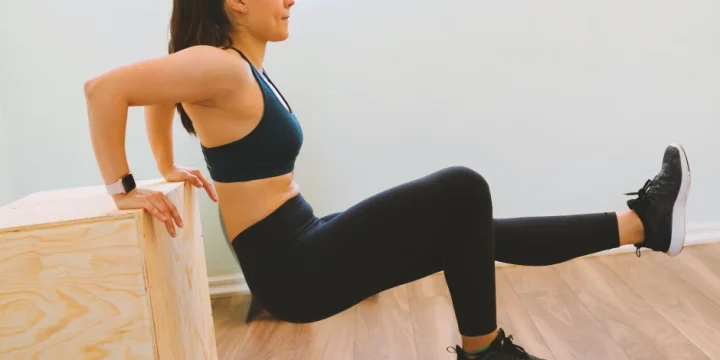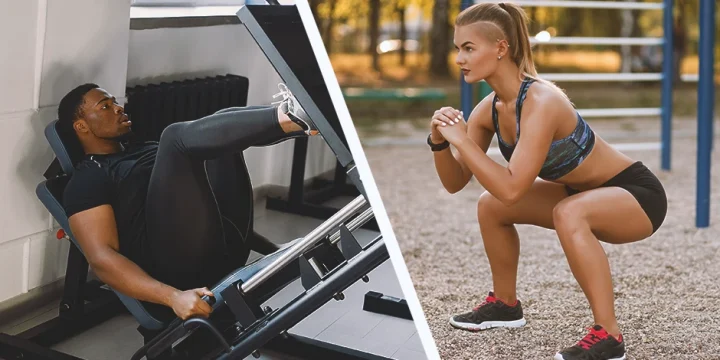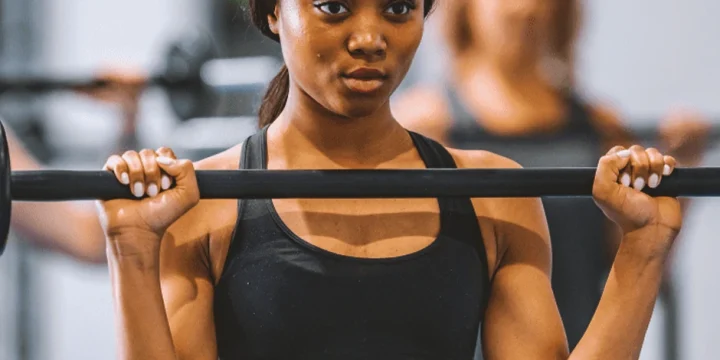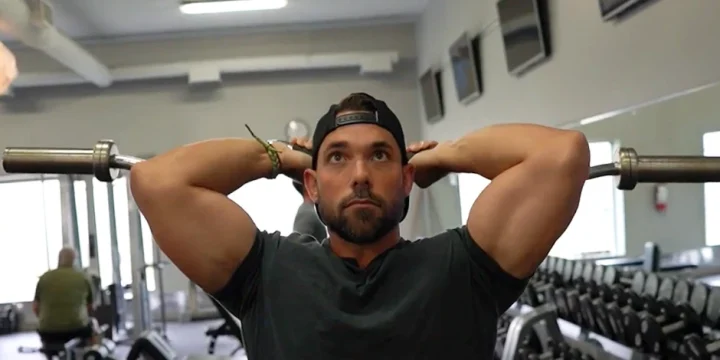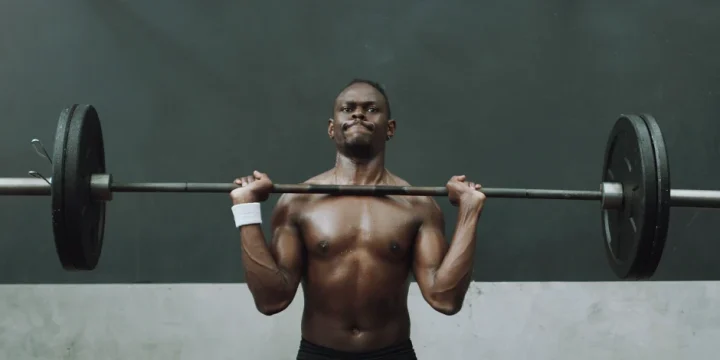The military press is a complex exercise that targets upper-body muscles.
It is a complicated move that necessitates proper form to avoid injuries.
As a certified fitness trainer and health and performance coach, I recall guiding a client named Mark through the intricacies of the military press. Despite his initial struggles with form, our focused sessions led to a notable improvement in his technique.
In this article, I will provide my expertise on how to do the military press, its variations, muscles worked, and tips for performing the exercise.
Also, consider incorporating the military press with these strongest pre-workout supplements into your training regimen for optimal functionality.
Quick Summary
How To Perform the Military Press

- Set the barbell to roughly shoulder height before adding the required weight.
- Stand with your feet shoulder-width apart, and position your hands at or roughly shoulder-width on the bar with a pronated grip.
- Step under the barbell and unrack it while maintaining a neutral spine. Have the barbell rest on your upper chest.
- Move backward, inhale, brace, tuck the chin, and press the bar above to lock out.
- Exhale as the bar reaches lockout and carefully reverse the movement while lowering the barbell back to your chest (the starting position).
- Repeat for the desired number of repetitions.
Tips For Performing It

- At the peak, reach tall, and don't worry about keeping your shoulders pressed down and back.
- At the top of the action, allow your elbows to turn and point outward, then tuck them close to the ribs at the bottom.
- Fight to keep the bar from rolling by sliding the wrists into extension and contemplating "rolling the knuckles toward the ceiling."
- Maintain the movement's momentum and avoid adding extra leg force by extending and flexing the knees.
- As you press, squeeze the glutes and stabilize your abs. When pressing, you should not lean back too far.
- As though you were attempting to look out a window from the top, your ears ought to be parallel to your biceps.
- Try a broader grip or vertical pressing if your shoulders are uncomfortable during the activity.
- You can utilize a staggered stance to keep your lower back from arching too far, but if you still can't control your anterior core, try a half-kneeling regression.
- Strengthening the rotator cuff and adjacent muscles regularly helps you protect against potential strain.
"Grip the barbell with both hands slightly wider than shoulder-width apart, allowing you to lock both arms out easily. You'll lose drive if you go any further."
- Mike Causer, Certified Strength & Conditioning Specialist
The Muscles Worked

From my practical coaching experience, I can affirm that the military press, or overhead press, is not just about upper body strength; it significantly engages the following muscles:
- Shoulders: Elevating your upper arms exercises your deltoid muscles on the front, side, and rear of your shoulders, building them equally with large weights for broader shoulders, as per research from the Sensors journal [1].
- Arms: Extending your elbows engages the triceps more than the biceps, as they have a greater muscle mass, leading to bigger arms [2]. Your forearms are also utilized for holding the bar.
- Rotator Cuff: This involves the teres minor, supraspinatus, infraspinatus, and subscapularis muscles, protecting your shoulder blades and stabilizing the shoulders, as described in various studies [3].
- Traps: Shrugging at the peak of each rep, as advised by fitness experts, develops the trapezius muscle groups on your neck's sides, forming ski-slope traps.
- Abs: The core muscles, including the abdominals, obliques, and lower back, support your body, as corroborated by the Journal of Physical Therapy Science [4].
- Legs: Although they don't move like in squats, legs still perform isometric work to maintain balance.
Military Press Variations

Variations of the military press to engage deltoids differently:
Seated Overhead Press
The seated barbell shoulder press is an overhead press variant that effectively increases upper-body strength and muscle without straining the lower back.
Sitting allows you to utilize heavier weights to focus on muscle building, increasing strength since your body is stabilized and more supported.
To perform the seated military press:
- Adjust the bar to roughly shoulder height while standing, then load the required weight onto the bar.
- Place a bench in an upright position beneath the bar.
- Sit on the bench press seat and use a pronated grip to unrack the bar.
- Inhale, brace, tuck the chin, and drop the bar to your upper chest.
- Exhale and return the barbell to the lockout position, then repeat.
Standing Military Dumbbell Press
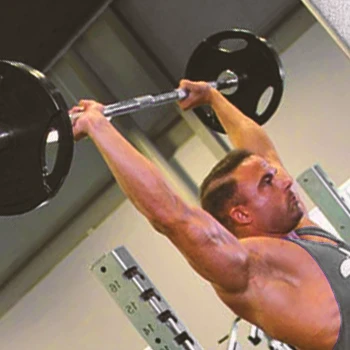
The standing military dumbbell press is among the most popular shoulder mass builders and upper-body strength developers.
To perform the standing military dumbbell press,
- Begin by grabbing two dumbbells and standing erect with your legs shoulder-width apart.
- Raise the weights to shoulder height on both sides, then twist your palms forward.
- Keep your head up and your gaze forward.
- Raise the dumbbells over your head slowly until both arms are nearly completely stretched.
- Don't pause at the peak of the action; immediately lower the weights back to the initial position and repeat.
Arnold Press
This is a variant of the overhead press. Instead of raising the dumbbell upward and downward in a straight line, you twist it and give depth to the range of motion.
To perform the Arnold press:
- Grab two dumbbells and stand tall with your legs shoulder-width apart to perform the Arnold press.
- Lift the dumbbells to roughly shoulder height on both sides, then rotate your palms to face your body.
- Your weights should now be in front of your shoulders. Your back should be straight, and your knees should be slightly bent.
- Slowly lift the dumbbells over your head while twisting your wrists so the palms are now facing forward (away from your body) while keeping your gaze ahead.
- Continue to raise the weight until the arms are nearly completely extended.
- Don't paise at the peak of the action before beginning to descend the dumbbells down to the beginning position, twisting your wrists until your palms are again facing your body, and repeat.
Smith Machine Overhead Press
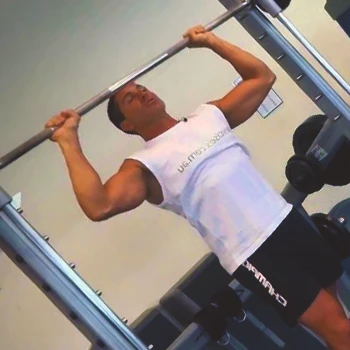
The Smith machine overhead press promotes muscular development and strength over the shoulder area.
Based on my years of coaching, I find that a Smith machine's defined range of motion is exceptionally beneficial for beginners to safely acquire and refine their movement patterns.
To perform the Smith machine overhead press:
- Sit on the bench press seat with back support right beneath a Smith machine's barbell.
- Grab the barbell with a double overhand grip just above shoulder height, somewhat wider than shoulder-width apart.
- Press the weight overhead with your hands as tight as possible until your arms are locked.
- Pause at the peak, then drop it back to the beginning, and repeat.
Related Posts:
FAQs
What Do Military Presses Work?
The military press works your shoulder, upper back, upper chest, core, and triceps muscles.
Does the Military Press Build Mass?
Yes, the military press builds mass. The military press is a complex barbell action that increases upper body mass and strength while improving performance in power, strength, and fitness athletes.
What Is the Difference Between Push Press and Military Press?
The difference between the push press and the military press is that the military press concentrates more on the triceps and shoulders than the push press since there is no motion from the legs.
References:
- https://www.ncbi.nlm.nih.gov/pmc/articles/PMC9781216/
- https://www.ncbi.nlm.nih.gov/books/NBK536996/
- https://www.ncbi.nlm.nih.gov/books/NBK531475/
- https://www.ncbi.nlm.nih.gov/pmc/articles/PMC6110226/
About The Author
You May Also Like
